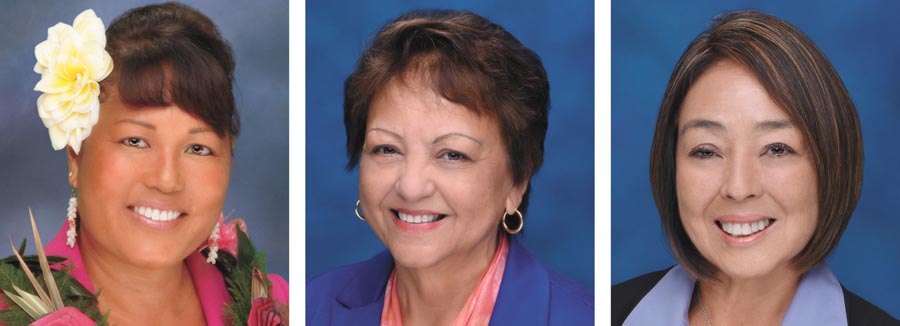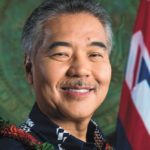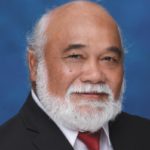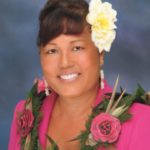
The Filipino Vote in Maui County
Things could look very different in Hawai‘i politics if the population of Filipino ancestry were to register and vote their full numerical strength. Though the state and local landscape is lightly sprinkled with successful Filipino elected representatives past and present (such as former Hawai‘i Governor Ben Cayetano, current state senator Gil S.C. Keith-Agaran and current Maui County councilmen Alika Atay and Don S. Guzman) the number of Filipinos who serve in elected office is relatively sparse given the numerical strength.
The most recent figures in the 2015 Maui County Data Book show Maui County with a population of 164,593 in 2015, up from 141,698 in 2009.
Of that number Whites are the largest group with 61,299, up from 54,371 in 2009.
The next largest ethnic group is Filipinos. The Filipino population grew from 21,108 in 2009 to 28,450 in 2015, and has almost certainly continued its upward trend.

“That’s funny, you don’t look Filipino”
When eyeing the Filipino vote in 2018, it’s important to remember that not all people who identify as Filipino look the part. Lots of voters identify themselves as affiliated with two or more ethnic groups. There are almost 40,000 Mauians who fit that bill, so while the data doesn’t give exact numbers for Filipinos, it’s certain to be a significant portion and increase the total number in the Filipino voter base.
Filipinos are followed by Mauians of Hispanic or Latino origin: 18,488; Native Hawaiian and other Pacific Islanders: 15,545 and Japanese: 11,575 according to 2015 figures.
The State Office of Election figures show the 2016 total county primary election registration was 91,138 and the turnout was a paltry 25,992 (29.6%). The general election was also thin soup—registration increased slightly to 93,912 and the turnout was a tepid 52,972 (56.4%).
In both the primary and general elections, Maui had the lowest turnout in the state and Hawai‘i had the lowest turnout in the nation. The key to winning the election in 2018 is not registering new voters; it is in getting those who are already registered to actually cast a ballot.
The 2018 election will certainly test whether the Filipino ethnic connection has any clout at the polls. The Maui mayor’s race is likely to be a three or four way contest. Don S. Guzman, presently a county council member representing Kahului, has already declared he is running and is campaigning hard for the office. Councilwoman Elle Cochran and former Councilman Michael Victorino have also announced their candidacies for Maui Mayor while Lt. Governor Shan Tsutsui recently announced he would not seek any office in 2018.
Guzman, a 48 year old Kahului attorney, lists many Filipino organizations in his campaign biography including past state president of the United Filipino Council of Hawai‘i, co-chair of the Filipino Community Task Force of Bini At Ani, and former legal counsel for the Maui Filipino Chamber of Commerce. He also chaired the 2006 Maui Filipino Centennial Celebration Coordinating Council.
But aside from Guzman, candidates with a Filipino orientation are few and far between. Areas with heavy concentration of Filipino voters include the island of Lāna‘i, where nearly all of the permanent population is of Filipino ancestry, Central Maui especially Kahului, North Kīhei, and portions of Lahaina.
Open seats in the 2018 election (i.e. with no incumbent) will include Guzman’s old Kahului council seat; the West Maui council seat now held by Elle Cochran, who has also announced she is running for mayor, the Kihei-Wailea-Mākena state house seat now held by Kaniela Ing, who recently announced a bid for Congressional District 1 which is located entirely on the island of O‘ahu, and other opportunities may arise as the date draws closer.
Thinking of running for public office and tapping into that large and as yet not very mobilized Filipino vote? The timetable for prospective candidates is posted on online at Hawai‘i Office of Elections Calendar http://elections.hawaii.gov/about-us/calendar/.
Filing for candidates opens on Feb 1, 2018 at 7:45 a.m. Nominations close on June 5, 2018 at 4:30 p.m. All filings must be submitted by that date together with other essential paperwork.
The August Primary Usually Counts for More than the November General Election
In Hawai‘i the primary election is the name of the game. Presently all of Maui’s elected representatives are either non-partisans or Democrats. Because of the heavy tilt toward the Democratic preference, most hot races for public office are decided in the August primary and with a few exceptions the general election in November is often only a formality.
Likewise, with expanded early mail and walk-in voting, as much as 30% of the total vote is already decided well before election day. To be sure, there are still some close races, where the winner is not decided until the final print-out in the wee hours of the morning, but most of the time, the nod goes to the trend set by the early vote.
Be more politically active in 2018: Be a voter—Make Our Filipino Vote Count
The deadline to register for the Saturday, Aug. 11, 2018 primary election is Thursday, July 12, 2018.
The deadline to register for the Tuesday, Nov. 6, 2018 general election is Tuesday, Oct. 9, 2018.
Those who register and vote in the primary do not need to re-register to vote in the general.
Find information relating to voter registration, mail in and walk in voting at http://elections.hawaii.gov/voters/registration/.
What’s different about the coming elections?
What a difference four years makes.
As Maui County gears up for the 2018 elections, only a year away, there are several obvious game changers that may indicate broader trends.
Upsets are the “New Normal”
One of the most obvious facts of recent political history is the new and very real potential for upsets. For example, until 2014, every incumbent governor since statehood who ran for a second term won that second term. But that all changed in the last gubernatorial race when Neil Abercrombie was soundly defeated by his Democratic opponent, underdog David Ige. The challenger won the primary in a spectacular upset and went on to win the general easily. Since then all bets are off.
Many think that Ige will find what goes around comes around and his fate will be “one and done.” But if that does happen it won’t be new or shocking, it will just be a sign of the times—the “new normal.”
Likewise “initiative” had long been an available option on Maui. That’s the process where a legislative question is put directly to the voters. Before 2014 no issue had ever been able to gather enough signatures to appear on the ballot. But an upstart coalition aka SHAKA cobbled together a GMO moratorium, and not only did the question make it to the ballot, it won at the polls.
Though the court struck the legislation down, it didn’t change the fact that suddenly there was a new, loud, effective and well-organized voting block estimated at about 19,000 strong. That was new. That was very new.
The election of 2016 just accentuated the power of the coalition when the slate calling itself the “Ohana” coalition and sponsored by the SAFE PAC (an offshoot of SHAKA) gained traction. The “Ohana” put up an endorsed candidate for every council seat and also ran candidates against the incumbents in State House districts 8, 11, 12 and 13 and OHA seats.
In the 2016 election, endorsed “Ohana” candidates incumbents Elle Cochran of West Maui and Don S. Guzman of Kahului ran #1 and #2 for the council. Kelly King and Alika Atay, both first time candidates endorsed by the “Ohana” won their seats for South Maui and Wailuku respectively.
The South Maui victory for King was also viewed as an upset when she beat incumbent councilmember Don Couch (who had been one of the top vote getters in the primary). To round out the surprises Alika Atay won a come-from-behind, final print-out-last-minute-squeaker to capture the Wailuku seat by beating opponent Dain Kane 23,322 to 22,513, in another upset.
There you have it: Close races, real opposition, new faces, genuine upsets, all part of the “new normal.”
As the voice of environmentalists, Hawaiian activists and those concerned with land use and water rights got louder and more organized, the voice of the traditional power structure diminished. Nothing put this change into stark relief like the closing of HC&S, the last of Hawai‘i’s operating sugar plantations. HC&S went from an agricultural workforce of more than 700 to fewer than a dozen. With its demise, the plantation—the power of the ILWU—continued to erode and a union endorsement was no longer an automatic ticket to election or reelection.
Women Coming on Strong
One area that really turned the corner in the last four years is the involvement of women in the political process.
There was a time, and it wasn’t that long ago, when the only way a woman could be elected on Maui was to fill out the term of a husband who died in office.
But that day is over. From across the political spectrum, women representing Maui have proven their ability not only to win but to win big.
When the votes were counted in 2016 the County Council had Elle Cochran, Stacy Crivello, Kelly King and Yuki Lei Sugimura. Lynn DeCoite was re-elected to the State House. Roz Baker continued to serve in the State Senate, Tulsi Gabbard, the county’s top vote-getter in the general election, was re-elected to the U.S. House, and Mazie Hirono continued in the U.S. Senate.
In 2014, first time candidate Tamara Paltin challenged incumbent Mayor Alan Arakawa and drew nearly 40% of the vote. In 2016, first time candidate Tiare Lawrence gave Kyle Yamashita a real run for the money and almost scooped the incumbent’s state house seat. Sugimura emerged victorious in the Upcountry council race but she had to beat two female opponents—Stacey Moniz and Napua Nakasone—to get there.
On the distaff side the bench looks deep, talented and rapidly developing political skills: more women elected, more women appointed and more women of all ages, sizes and political beliefs coming up through the ranks.
If you’ve gotten this far here’s a new way to understand the current political climate as the 2018 election comes into focus. When it comes to the players there are four flavors—and they are all Democrats
Democrats: Old-Old, New-Old, New, New-New
There are the Old-Old Democrats, New-Old Democrats, New Democrats and New-New Democrats
The Old-Old Democrats are the most familiar and the most readily identifiable. Three easily identifiable specimens of this breed are State House Speaker Emeritus Joe Souki, former councilmember Mike Victorino, and present councilmember Riki Hokama of Lāna‘i (whose dad, the formidable Goro Hokama, was the Lāna‘i member and council chair before him).
These are public officials whose identity was forged by the plantation era and who matured in public office with the growth of tourism and real estate speculation that followed. These are people who came up when the Jaycees and the County Fair were all stepping stones to winning election and reelection.
On the bad side, the Old-Old Dems are like the political version of petrified wood, a tad on the fossilized side and all that goes with it. As a cohort they tend to be set in their ways and have a mighty hard time making new friends. On the good side, get to know an Old-Old Democrat and find a wealth of in-depth knowledge and often a well concealed but tender heart, most of it, unfortunately, reserved for a very select group of friends and supporters.
The New-Old Democrats are a hybrid version of the Old-Old Democrat. Scratch a New-Old Democrat and you’re apt to find a very fortunate political appointment in their bio.
*Think Shan Tsutusi, who was State Senate President and then was appointed Lt. Governor.
*Think Brian Schatz, who was Lt. Governor and was transformed with the stroke of the governor’s pen to senior Hawai‘i U.S. Senator, filling the very big shoes left by the death of the late Daniel Inouye.
*Think Gil S.C. Keith-Agaran, a successful attorney who, with only the teeniest bit of finagling by his well-connected law firm, got the nod to fill the vacancy created by the death of State Rep. Bob Nakasone.
All of the New-Old Democrats are younger, they’re talented and personable but the universal trait they share is friends in the right high places. They’re not bad and they’re not dumb, but they’re the kind of “retro” that results when you depend on the connections those who went before you to make your luck.
Comes next the New Demo-crats: Do you feel the Bern?
The New Democrats are younger, hipper, and apt to be a techie or a wonk or both. The New Democrats rely heavily on their phones and organize through social media. They are more policy driven, more outspoken, more active and went heart and soul for Bernie Sanders in 2016. The New Democrats have position papers and ideology; they love nature, sacred rocks, tiny houses and march collectively to a drummer that is heard either distantly or not at all by their Old-Old and New-Old counterparts. Ready or not as the changing of the guard progresses the New Democrats will be coming next to a smart phone near you.
Looking for your New Democrats? Look at Tulsi Gabbard and Kaniela Ing and a host of vocal others who made sure that the Hawai‘i Democratic Presidential Caucus went to Sanders. According to a March 29, 2016 New York Times report, Sanders won the Aloha State caucus by a resounding 69.8% with 23,530 votes of 33,716 cast. Out here in the mid-Pacific, Hillary Clinton (a true Old-Old Democrat albeit the female version) was a distant second.
As for the New-New Democrats, well, it’s come full circle: the New-New Democrats are people who want to stay in public life and keep winning elections but finds it inconvenient to be a Republican in the age of Trump and a place where all the winners are Democrats.
For examples of New-New Democrats look no farther than Alan Arakawa, who would like to be Lt. Governor, but probably thinks he’ll have a better chance now that he’s a Democrat.
Then there’s Don Couch, who didn’t have to state a party preference when he was running for the council. Now that he’s eyeing a state house seat (where Republicans are mighty scarce and at the bottom of the food chain) Couch has a brand new Democratic registration.
In truth the New-New Democrats are very, very similar to the Old-Old Democrats or as the French would put it: “Plus ça change, plus c’est la même chose;” The more it changes the more it stays the same.
Where Are The Votes?
More than half the registration in only 11 precincts.
The areas of greatest registration have shifted substantially in recent years from Central Maui to Ha‘ikū, Lahaina, Kula and Kihei. Maui County has more than 30 voting precincts spread out over six districts numbered 8, 9, 10, 11, 12 & 13. In the 2016 elections, more than half of all eligible voters were concentrated in only 11 precincts.
Though registration has continued to grow, the percentage of eligible voters who actually vote is at an all-time low. In each of these precincts for every person who cast a vote there were two and in some cases three more who could have voted but didn’t.
With numbers like these even a small change in the turnout can make a big difference in the results.
In 2016 the precincts with the largest number of registered voters were:


Who Got the Most Maui County Votes in 2016
Primary Election
Top 5 Vote Getters 2016 – Maui County
1) Sen. Brian Schatz (D)* US Senate 18,264
2) Rep. Tulsi Gabbard (D)* US House 17,919
3) Mike White* Makawao Council 13,328
4) Don Couch* S.Maui Council 11,305
5) Yuki Lei Sugimura Upcountry Council 10,048
Of the top five Couch was defeated in the general election. Sugimura was a first-time candidate and went on to win in November. All the council races are nonpartisan, i.e. no party preference is declared by the candidate. Names with (*) were incumbents.
General Election
Top 5 Vote Getters 2016 – Maui County
1) Tulsi Gabbard (D)* US House 41,046
2) Brian Schatz (D)* US Senate 37,214
3) Hillary Clinton (D) President 33,480
4) Elle Cochran* W. Maui Council 31,970
5) Don S. Guzman* Kahului Council 30,764
(*) Incumbent


Photo courtesy Gil Keith-Agaran

Photo courtesy Maui Independent

Photo courtesy MauiCounty.us

Photo courtesy governor.hawaii.gov

Photo courtesy Maui Democratic Party

Photo courtesy MauiCounty.us

Photo courtesy The Hawai‘i Herald

Photo courtesy Hawaii.gov

Photo courtesy Wikipedia

Photo courtesy Mayor Alan Arakawa

Photo courtesy Wikipedia

Photo courtesy Wikipedia

Photo courtesy MauiCounty.us

Photo courtesy MauiCounty.us

Photo courtesy MauiCounty.us

Photo courtesy Wikipedia

Photo courtesy Wikipedia

Photo courtesy Wikipedia

Photo courtesy MauiCounty.us

Photo courtesy MauiCounty.us
